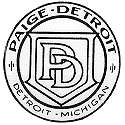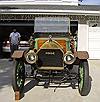| < 1911 | 1913 > |
1912 First "Paige"
| Model: | Four |
| Cylinders: | 4 |
| Horsepower SAE: | 25 |
| Wheelbase: | 104 |
Late in 1911 Harry Jewett decided to refine the name of the car. Towards the end of 1911 the company advertised its 1912 line of autos as usual, but an ad in the January 4, 1912 of The Automobile identified the car simply as a Paige
and no longer as a Paige-Detroit
.
Models were given stylish names, a practice that would continue for another ten years. For example, the two 1911 touring car models evolved into the Pinehurst and the Beverley. Plus, the shift lever and the emergency brake lever were moved inside next to the driver, eliminating the trouble and the danger of operating levers by reaching over the doors.
The new 1912 models had attractive styling. The LaMarquise four-passenger coupe was certainly a unique combination of carriage styling with an automobile chassis. The interior was finished in mahogany, green broadcloth, and green leather. The exterior was green, and the model had red running gear. The company described it as a colonial
coupé, because of its side-lamps. A Paige ad boasted that possession of the LaMarquise stamped the owner as one who seeks the best in life
and who will have
the classiest car along the curb,
whether it is before the opera house or the club.

- Coupé, four-passenger, La Marquise, $1,600
- Raceabout, two-passenger, Brooklands,
mile a minute
type, $975 - Roadster, Kenilworth, $975
- Runabout with folding deck and auxiliary tank, two-passenger, Rockland, $925
- Touring car, fore-door torpedo-type, Beverley, $975
- Touring car with detachable rear seats, Pinehurst, $900
Later in the year these models were joined by a seventh:
- Touring car, five-passenger, Brunswick, $1,000
Almost immediately the lineup was revised. By January of 1912 all 90-inch wheelbase models were dropped, including the original Challenger roadster, and two proposed models: the Princess coupe and the Newport fore-door roadster.
At this point, then, the 1912 lineup consisted of six models with prices ranging from $900 to $1,600, including several open sporting cars. All were built on the Paige 104-inch chassis and with the Paige 25 HP power plant.
Regular equipment included windshield, top, 5 black enamel lamps, generator, horn, jack, tools, and tire repair outfit. A set of five Quick Demountable Rims, including tire irons, were a $15 option for touring cars ($12.50 on roadsters). If desired, for $25 a self-starter and Press-O-Lite acetylene tank could be installed.
 |
 |
 |
 |
| 1912 Paige Brunswick (Scott Odle Collection) | |||
During the course of 1912 Paige adopted the Disco self-starter, allowing the Paige owner to start his car from the seat with none of the old inconvenience of cranking. Paige was the first popular-price car to adopt the Delco ignition system, which replaced the Bosch magneto installed in initial 1912 models. That same year Paige also became the first in its field to use a cork-insert, multiple-disc clutch enclosed in the flywheel and running in oil.
 |
 |
| 1912 Paige Motor Left Side | 1912 Paige Motor Right Side |
- Cadillac is the first U.S. car to feature an electric starter, along with new lighting and ignition devices.
- Standard Oil Company opens its first gas station in Cincinnati, Ohio.
- Carl Fisher of the Indianapolis Motor Speedway promotes building an all-weather, gravel highway, the Lincoln Highway, between New York City and San Francisco.
- The price of a Ford Model T, introduced in 1908, drops to $575.
- At the 1912 London Show, Argyll introduced a car with brakes on all four wheels.
| < 1911 | 1913 > |



